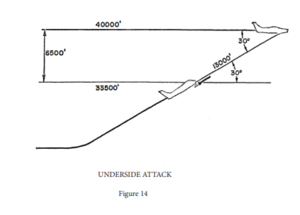Six-O’clock Attack with AIM-9B -- Best Type of Attack Against a Non-maneuvering Target with the 20MM Cannon
The underside or six-o’clock-low attack, is the best possible attack we can execute, as we acquire advantages in:
- IR
- G
- Surprise
- Aircraft Performance
IR Tone contrast is maximum against a blue-sky background. Here, the lead sulphide cell can discriminate between he hot metal of the jet’s tailpipe and the blue sky. At ranges of 20,000 feet and greater, the IR pattern becomes longer than the range of the missile. The G limitation, in relation to missile range and IR tone contrast, is almost non-existent (see figure 13). For fighter and target at 35 - 80,000’,
Vf = .9 Mach = 873’ / second
Vt = .9 Mach = 873’ / second
Gt = 2
Gr @10° = 2 + .985 = 2.985
Gr @ 20° = 2 + .94 = 2.94
Gr @ 30° = 2 + .866 = 2.866
S = Vf x Vt x Sinθ / 32.2Gr = 23,700 x Sinθ / Gr
For θ = 10°
S = 23,700 x 0.174 / 2.985 = 1, 380'
For θ = 20°
S = 23,700 x 0.342 / 2.94 = 2, 760'
For θ = 30°
S = 23,700 x 0.5 / 2.866 = 4,130'
This figure shows that, as we approach our cone of maximum performance, we find that we can generate 2.866 radial G while pulling 2 total G. Applying this value to the figure above, we find that we can launch Sidewinder at a range as near as 4,130 feet at 30° angle-off without exceeding our 2-G limitation. At 20° angle-off while generating 2.94 radial G, we find that we can launch as near as 2,760 feet without exceeding the 2-total-G limitation. At 10° angle-off, we can launch at a range as close as 1,380 feet. To put it another way, when we launch our missile against a target from an underside attack, the missile must turn in the direction of gravity to set up its collision course – thus, gravity, acting in the direction of the missile’s turn, actually causes the missile to fall toward the target. In other words, the missile has a maneuvering advantage, since it generates a radial G greater than its total G. This advantage we have already considered in the previous illustration. Surprise, the third major advantage, is greatest when attacking a target from underneath, or from six-o’clock-low, since this is the target’s blind area. Aircraft Performance, the forth major advantage, can be understood by referring to figure 14.
Here, we are an attacker ready to launch AIM-9B against a target traveling .9 Mach at 40,000 feet. Applying a rule-of-thumb for co-airspeed, we see that the fighter can launch from a max range of about 13,000’. Now, if the attacker sets himself up to launch from 30° angle-off, this means that he can launch from a position 6,500 feet below the target. To achieve this launch position, an attacker may start his attack at even a lower altitude – the distance below dependent upon his airspeed. For example: An F-100 at 1.1 Mach may start his attack with an altitude differential of at least 10,000 feet – in this case, at 30,000 feet altitude. From this illustration, we can see that AIM-9B gives an attacker an additional performance capability, in that the attacker is not required to attain the target’s altitude. In summary, since the underside attack provides the greatest advantages – IR, G, surprise and performance – we should employ this attack whenever possible. As you will see later, this holds true for both fighter-versus-bomber and fighter-versus-fighter. When compared with a gun attack, AIM-9B is far superior, since the range of the missile allows us to get into an effective cone of fire.
Six-O’clock Attack with AIM-9B -- Best Type of Attack Against a Non-maneuvering Target with the 20MM Cannon
